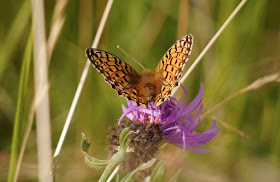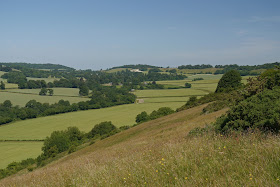Another butterfly walk, chosen like other recent ones from David Newland's wonderful Where to see butterflies in Britain. Today's target species was the Chalkhill Blue, which I have never seen.
There are two paths from the car park at Aston Rowant. I look the left hand one, closest to the motorway and followed a descending route through woodland, with mounting traffic noise - not awfully auspicious. After about half a mile however you emerge at the bottom of Beacon Hill. I looked around and immediately saw my first Chalkhill Blue!
I then made a very slow movement along the sunken track ending at a wooden stair rail. I then lopped back along a higher path and came round again. The view back shows the lower hillside on the left and the point where the M40 cuts through the Chilterns is on the far right.
There were just loads of Chalkhill Blues, especially on the clumps of Large Thyme, but on other plants to. They were not too bothered by my presence and just continued fidgeting around on the flowers, sometimes disturbed by the strong breeze or by other insects. The characteristic and distinctive silvery blue was very obvious and it was instructive to see how variable the back markings on the wing margins actually were. The hind wings consistently had black dots surrounded by white, but the fore wings sometimes had clear black dots on a dark ground, sometime fuzzy dots and sometimes no real dots at all, just a black edge.
The undersides were actually more of a creamy colour than photos suggest and the coloured dots varied between pale orange and quite red.
The early clump of Large Thyme was also host to this beautiful Small Copper ...
... and a spectacularly bright Small Tortoiseshell, as well as innumerable Small Skippers.
Later, I had a very nice shot of a Large Skipper.
There were also legions of Meadow Browns, a few Small Heaths, some Marbled Whites, Large and Small Whites, a Comma and a Red Admiral. So quite a good haul.
The hillside flowers included this unusual Dwarf Thistle ...
... some Clustered Bellflowers ...
... and this lovely Pyramidal orchid.
After a thorough exploration of the lower hillside, I walked on along a climbing track and turned right to reach the path at the top of the hill, just below the tree line, and followed this back to the car park. It was noticeably windier up here and there were many fewer butterflies.
Conditions: hot and sunny again.
Map: Explorer 171 (Chiltern Hills West).
Distance: about 2 miles.
Rating: four stars.











































